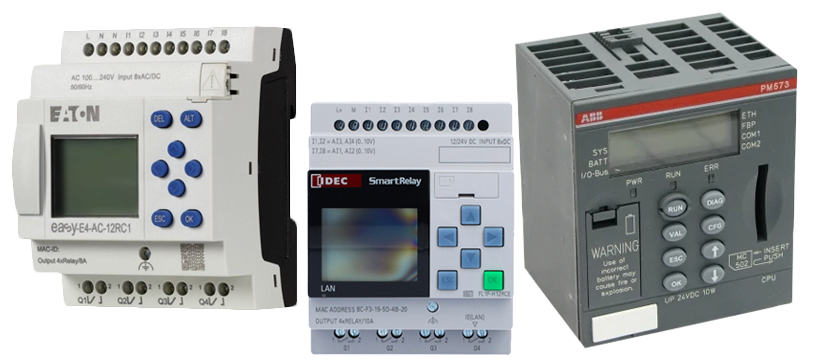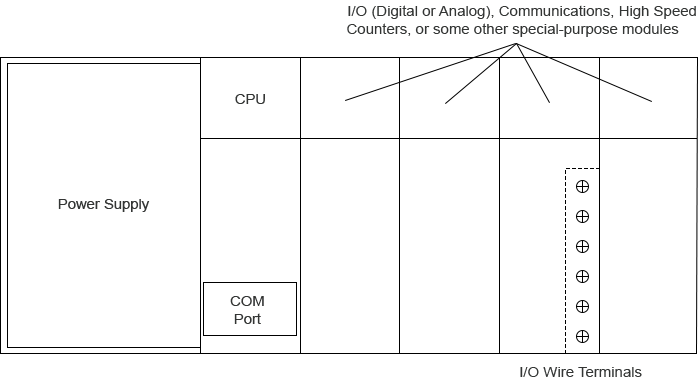PLC Programming - Programmable Logic Controller Basics

Programmable logic controllers (or PLCs) are solid-state devices designed to perform logical decision-making for control applications in the industrial environment. The PLC was immediately accepted in the automotive industry and is commonly found in applications in many different industries.
The PLC performs functions that formerly required relays, solid-state electronics, or mini-computers. PLCs are lightweight, rugged devices that operate without fans, air conditioning, or electrical filtering.
PLCs have three components: a processor, power supply, and an input/output (I/O) section.
Shop PLCsThe processor, or the brain of the PLC system, is a solid-state device designed to perform a wide variety of production, machine tool, and process-control functions. Conventional electromechanical devices, relays and their associated wiring formerly performed these functions. Processors provide these same functions, in a wider scope and variety of control functions, with minimal effort, making the PLC a much more popular choice.
The processor operates on DC power (± 5V), that is supplied by the power supply. Internal DC power is also routed through the processor and operates a portion of the I/O and devices connected to the service port of the PLC. Once the ladder-diagram program is entered into the processor, it remains until changed by the user with one of the programming devices. The program is unaltered through power failure or power off conditions.
The power supply for a PLC converts the input source power into voltages required for internal circuitry. In some cases, it also provides an isolated VDC supply to power DC input circuits, switches, and other indicators. The power supply of the PLC is an essential component of running the PLC.

Electrical noise such as spikes in the power lines or load kick-back would have a serious impact on a PLC's internal circuits since its CPU operates at very low voltage levels. This is where the Input/Output (I/O) portion of a PLC plays a critical role. The I/O, both inputs and outputs, protects the CPU from electrical noise. The I/O section is where status signals are filtered to remove noise, validate voltage levels, and CPU decisions are made and put into operation. The PLC Inputs provide their status to a storage area within the CPU and outputs are driven from similar stored status in the CPU.

Real-world devices such as pushbuttons, limit switches, and sensors are connected through the input modules in the PLC. These modules detect a change in the state of input signals and provide a stored image to input elements in ladder logic. The input elements simulate the actions of relay contacts within the PLC. In turn, output elements are "energized," which produces desired output signals to drive loads such as motor controllers, contactors, solenoids, and pilot lights, via the output modules in the I/O's. As a general rule, each instruction in ladder logic requires one word of memory. Each instruction is programmed so that series contacts are “ANDed” and parallel contacts are “ORed”.
PLCs are available with operating voltages from 12V to 240V AC or DC, and I/O's up to 512
PLCs are simple to program. They use a relay ladder language that's very similar to magnetic relay circuitry. Engineers, technicians, and electricians can learn to program the PLC without extensive training or experience. There are numerous advantages in using PLCs versus a relay or solid-state electronics.
In a PLC, changes can be accomplished quickly, and in most cases, without hardware modifications to the controller. PLCs are reusable and indicator lights on the PLC at major diagnostic points assist in troubleshooting. It's reliable, designed for the industrial environment and easy to maintain. Along with its cost savings, the PLC is flexible and able to perform multiple functions.
